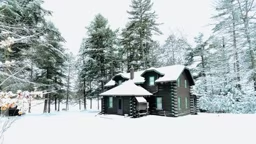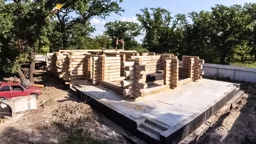| By Tracy Fox According to the U.S. Green Building Council, "green building" (also referred to as "eco-design" and "sustainable design") has an increasingly profound effect on our environment, our health and available resources. This movement encourages professionals and consumers to evaluate the current state of our planet — and to make thoughtful choices about how we use energy, water and building materials. Here are some ways for your log home to "go green." Energy StarsAccording to the U.S. Department of Energy, if just one in 10 households bought Energy Star-rated heating and cooling products, it would prevent over 17 billion pounds of pollution annually. To further "energize" your log home, replace older appliances (which account for about 40 percent of the average utility bill) with their Energy Star-compliant counterparts.Power PlayGeoff Badger, president of Badger Brothers Log Homes of Strongsville, Ohio, is a proponent of geothermal power (also known as "geoexchange" and "ground-source heating/cooling"). In the winter, geothermal heat pumps (GHPs) draw warmth from below the ground through a series of pipes (called a "loop") and transfer it to air circulated through interior ductwork. This process is reversed in the summer: Heat is extracted from air inside the house and pumped out.Sun CatcherSunlight is another "clean" energy resource that produces an infinite supply of free energy with no greenhouse gases. There are two major ways to use this superpower: photovoltaic (PV) solar power and passive solar design. PV systems feature a PV panel, which captures the sun's energy; an inverter, which converts it into usable alternating current (AC); and a monitor that allows you to see how much energy your system is producing each day. Solar electrical power systems are extremely efficient — their ineffectiveness on overcast days is a myth.The cost of a 3,500-watt PV system averages about $15,000 but, depending on electricity rates, they usually pay for themselves in seven years. The overall goal: getting your electricity bills to $0. You may also consider a sunroom or solarium to brighten up your living space.No Material ExcessAnother major tenet of green building is the effective use — and, if possible, reuse — of natural resources. The log-home industry's widespread use of standing dead trees is a fine example of resource efficiency. And many log-home owners choose to incorporate recycled materials into their home's design. For example, reclaimed wood from old barns can be transformed into beams, wide-plank floors, doors and furniture. Using renewable or sustainable resources (i.e., materials that grow back quickly after they are harvested) offers similar benefits.Many flooring options fall into this category, including easy-to-clean cork, which is typically $8-$11 per square foot. Available in a wide array of colors and patterns, cork flooring is made from ground-up wine-stopper waste that's formed into sheets using minimal adhesives. True linoleum, made from sawdust, linseed oil and pine rosin, is another all-natural material that offers non-toxic durability and style for log homes. Also look for ways to incorporate durable materials that rarely need replacing. Some energy-conserving windows come with a 50-year guarantee. Meanwhile, metal roofs often last the life of your home (compared with an average of 15 years for asphalt tiles). Or take another road by using EuroSlate, durable and low-maintenance roofing tiles made from recycled auto tires. Once you move in, keep the green spirit alive. Shop antiques stores, flea markets and salvaged material outlets for gently used furnishings and other home supplies. And, of course, don't forget to recycle. |
Green Building Tips & Techniques
While the primary goal is to protect the environment, green-building practices often result in financial savings for consumers — including log-home owners.







_11868_2023-04-27_10-18-256x288.avif)



